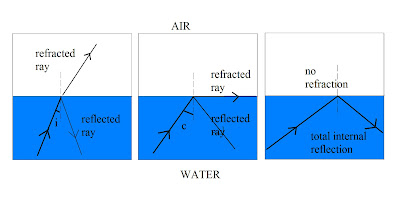I have previously covered refraction, and its role in making rainbows. To refresh your memory, refraction is what happens when light travels from one medium (like water or plastic) to another medium (like the air or glass). The angle that the light follows through the second medium depends on the angle that it strikes the boundary of the two mediums at. This is because it’s caused by a change in the speed of the light wave. (see Refraction: Behind The Rainbow)
Whenever a ray is refracted, there is also a little bit of that light ray that is reflected by the surface boundary. This is because with a flat boundary between the two mediums some of the light waves will actually think that there is a mirror there, and get reflected back. The amount that is reflected depends on the angle of incidence (the incoming angle). After a certain angle, which is called the critical angle, there will not be any refraction, only reflection. This is called total internal reflection and it’s very important for many of the things we use today.
It’s interesting that different materials have a different critical angle c, and it explains why some things seem to have more internal light than others. The critical angle of water is 49ºC, quite high, so light going through it at many angles will refract and head away from the water. For acrylic it’s 42ºC and for glass it’s 41ºC, so already it’s easier for light to get trapped inside by total internal reflection. But for diamond it’s a tiny 24ºC. That means that any light trying to leave the diamond’s insides that hits the edge at more than 24ºC will be totally reflected back inside. It’s easy to see then, where the diamond gets its sparkle!
But aside from shiny jewels, there are other reasons to like total internal reflection. You may have had a periscope as a child, that you could use for spying round corners on your siblings. No doubt that is was made from mirrors, but the best ones use glass prisms inside set up so that total internal reflection brings the light to your eye.
Another handy little use for this is to make those reflectors on bikes light up so cyclists can be seen better. If you look at one you’ll see that whilst the outside is flat, the inside has some sort of texture, and that is carefully measured so that two total internal reflections occur and send the incidence ray (incoming) back out so the reflector appears light and the cyclist is more noticeable.
But perhaps the most important use for total internal reflection is optical fibres. Nowadays, we know this best because our internet is increasingly reaching us through “fibre optics”, but these little fibres have long been helping to make things faster, and more efficient, than using normal wires to send data.
An optical fibre is made of glass or plastic, and it’s very thin so that it can also be flexible. When the light enters one end, it’s reflected internally right the way to the other end, where it will be as bright as when it went in, even if the fibre is several kilometres long. This meant a big change to things like telephones, where huge signal boosters were no longer needed for long distance phone lines.
Today, the range of applications is vast, from novelty lights and Christmas trees to endoscopes for looking inside someone’s body to tiny little cameras, we have total internal reflection to thank for it all.




No comments:
Post a Comment